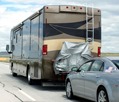Class A recreational vehicles are
the largest of the three types of motorhomes
and
one of the two most popular kinds of RVs for extended use.

See our up-to-date listing of
Class A Motorhome Manufacturers
There is a wide variety of widths, lengths, and heights of Class A motorhomes, usually in a “boxlike” or “bus” shape.
Class A’s can be divided by method of build into two subtypes:

- Chassis built—The coach is built on a bare-bones chassis—cab not included—supplied with the following major components: frame, engine, fuel tank, axles, drive train, wheels, tires, steering column, engine and braking controls, and dashboard instruments.
 Bus Conversion—The motorhome begins as a completed bus that is then converted into a recreational vehicle. Some manufacturers change the exterior very little, while other conversions are significantly modified inside and out, with little resemblance to their original configuration
Bus Conversion—The motorhome begins as a completed bus that is then converted into a recreational vehicle. Some manufacturers change the exterior very little, while other conversions are significantly modified inside and out, with little resemblance to their original configuration
Class A’s are powered by either diesel or gas engines and the engine may be either in the front or the back. Often, Class A RVs are referred to by the location and type of engine they have, most commonly if it’s a diesel engine in the rear, in which case, it is referred to as a diesel pusher.
 Like all motorhomes, Class A’s serve as both a home and a vehicle, with easy access to the living area from the driver’s and passenger’s seats. They often include spacious, open interiors, especially when equipped with slides. With basement storage—storage areas below the living area that are accessible from the outside—along with interior cabinets and closets, these large motor homes have the most storage space of all RV types.
Like all motorhomes, Class A’s serve as both a home and a vehicle, with easy access to the living area from the driver’s and passenger’s seats. They often include spacious, open interiors, especially when equipped with slides. With basement storage—storage areas below the living area that are accessible from the outside—along with interior cabinets and closets, these large motor homes have the most storage space of all RV types.
The size and shape of Class A’s allow the manufacturers to develop a variety of floor plans.
Just as with other RV types, weight added by slides, cabinetry, and other amenities reduces the cargo-carrying capacity.
According to the RV Consumer Group, Class A motorhomes, especially those with slides, have more structural and safety issues in crashes compared to the two other classes.
While easy to drive on the open road, their size can make navigation around on town and city streets difficult. They can also be more difficult to park than their smaller cousins, especially in campgrounds. A large number of state and federal campgrounds have a limited number of sites able to accommodate Class A’s.
With the elevated driver location and additional width of the most Class A’s, judging clearance on the right side of the vehicle may be difficult. As well, clearance under trees and structures—canopies at filling stations, for example—can be an issue due to the height of the vehicle plus top-mounted equipment.
Links to USA Class A motor home manufacturers
(with listings of current models)
American Coach—The Heart of Luxury, The Soul of freedom
Coachmen RV—Leader to the Great Outdoors
Entegra Coach—Adventure in Comfort
Featherlite Coaches—Yacht-Quality Luxury for the Open Road
Fleetwood RV—Explore Your World Like Never Before
Forest River—Open Up And Explore
Foretravel Motorcoach—Your Imagination Realized
Hoffman Coach—A Motor Home Conversion Company
Holiday Rambler—Built for the Road
Jayco—Find Your Freedom
Liberty Coach—Miles Ahead… Again and Again
Marathon Coach—Get out and Explore. Resort Living Reimagined
Millennium Luxury Coaches—Your Journey Starts Here
Newell Coach—When Power Meets Luxury
Newmar—The Journey Just Got Better
Precision Coach Inc.—Motorhome renovations, RV Bus conversions
Prevost—Get Inspired to See the World
Terra Wind—The Land. The Lake. The Luxury. (amphibious motorhome)
Texas Custom Coach—The Premiere Coach & RV Remodel and Repair Shop
Thor Motor Coach—Made to Fit
Tiffin Motorhomes—Make Room for High Adventure
Winnebago—Here for Wherever you Go

